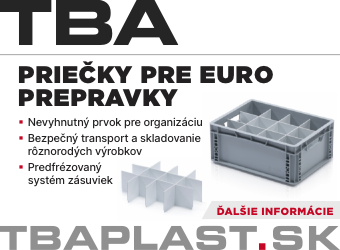Weekly commodity price report
Here are the market prices of various types of commodity plastics PE-LD, PE-HD, PP and PS in Central and Eastern Europe with a delay of 5 weeks. The data was processed by our partner myCEPPI.
Are you interested in current prices for commodity plastics? You can order Weekly polymer price reports from our editors.
Prices for this week 48/2019
The following factors influenced “commodity” polymer prices and price expectations last week:
- BRENT oil price 63.97 USD/barrel, increasing prices,
- EUR/USD: 1,1047, a stagnant Euro
- NAPHTHA (European): 529.93 USD/t, further increasing prices
- According to polymer producers, November demand is average or slightly better,
- Import from outside of Europe is low.
- Spot markets seem to stand still,
Is it even lower? Most converters expect further polymer price cuts in December. Moreover, most of the players in the market. However, a 7-9% rise in the prices of feedstocks - crude oil and NAPHTHA - suggests the opposite. If oil and NAPHTHA prices remain at this level, a slight increase in monomer prices of EUR 0-20 may be envisaged. (It is important to note that there is one week left in the month and the price of these feedstocks may fall back. Thus, a decrease in the monomer price is not excluded.)
The question is how do polymer producers react to a possible increase in monomer prices?
Let's see the facts:
- By the last week of November, Central European producers had sold almost everything. Their November closing stocks are low. As a result, they will have less selling pressure in December. In addition, a small increase in inventory levels is possible.
- Current margins are extremely low. Polyethylene grades can practically only be sold close to the monomer price and LDPE can only be sold below that. Prices below € 900 are not a realistic option for Central European polymer producers. There is a lot of pressure to increase the margins, but at least keep their level. Thus, in case of a possible monomer price increase to increase prices.
- The current price level is no longer attractive to suppliers outside Europe. Thus, there is little import in both European and Central European markets. This seems to be contradicted by the fact that many offers are circulating in the market, but there are no significant quantities behind them. There are only a few items in the traders' warehouses.
- The weak euro does not support imports. Thus, no major import shipments are expected in the next 2 months.
- The current "weak demand" is due to the confidence of converters in the long-term supply. Thanks to new North American and Russian capacities. And there is a general lack of confidence in the development of the European economy. The consequence of 'weak demand' is supply which appears to be plentiful. They are unlikely to increase their stocks in December.
- The broad supply is backed by an increase in the number of sellers. But this is not proportional to the increase in supply. Due to the virtual supply, the large number of sellers and the increasing communication, converters feel that the market is saturated with feedstock.
- December is a 3-week month. Demand will stop on 20th and will only resume on 6th January.
With all this in mind, with the very conceivable monomer price increase, no polymer price increase is expected. It is more likely that there will be a polyolefin roll over compared to current mid-range prices. Thus, the polyolefin price level below EUR 900 is once again inaccessible.
And the reduction of butadiene by EUR 50 adds to the doubt. This also predicts a possible further decline in SM prices. Imports outside Europe are also low on the PS market. However, demand will not be too strong in December. Thus, producers will have to consider the extent to which they anticipate an SM price drop. Are the full price reductions passed on to converters?
POLYOLEFIN GRADES
LDPE prices were in a range of 910-980 €/t last week in Central Europe. The cheapest prices on the spot markets were in the range of 900-930 €. However, spot market demand was low. Not many transactions occurred. Converters expect further price reductions in December, which manufacturers will also grant if monomer prices fall. However, in the case of a monomer price increase, roll over is likely.
Typical HDPE prices were in a range of 910 - 1,020 €/t in Central Europe last week. Demand is weak for all grades. There is a seemingly large supply, and in many cases this discourages customers from buying. Another important factor is that packaging users are also cautious about minimizing their inventory levels, fearing that the European recession will unfold. Last week's trading price ranges were as follows
- HDPE BM 920-980 €/t,
- HDPE IM prices 930-1,020 €/t,
- HDPE FILM grades 910-990 €/t,
There are few non-European imported products on the market. In many cases, although cheaper, converters feel that now is not the time to try new products.
Typical HDPE (100) prices were in a range of 1,160-1,200 €/t last week. Prices have not changed. Demand is expected to pick up from late January.
LLDPE C4 prices were in a range of 920-1,000 €/t last week, depending on the grade and application area. Prices did not change, but supply weakened as the euro weakened. Smaller buyers see a price increase of around € 10. Prices are likely to increase slightly in the coming weeks.
mLLDPE (C6) prices were in a range of 1,020-1,160 €/t last week. There is a slight oversupply on the market.
Typical PPH Raffia prices were in a range of 920-1,030 €/t last week. Demand by manufacturers and end users has picked up. However, distributors are still not competitive enough. Spot markets have also stopped. Buyers expect price drop in December. But in the event of a monomer price increase, polymer prices are also likely to rise. Especially in the lower price ranges.
The price of PPM IM products with medium melt index was in a range of 920-1,020 €/t last week. Prices have not changed compared to the previous week. The price of products with high flow index was in a range of € 1,020 - € 1,080/t. Demand is low. But the polymer producers also sold their production. Prices are likely to have now reached their 2019 lows. Thus, a possible monomer price increase could also lead to a smaller polymer price increase in December.
Typical PPC prices ranged from 1,080 to 1,160 €/t in Central Europe. They did not change compared to last week. Demand by converters is weak. End of season. Very few transactions were made in the market.
PPR prices were on the average in a range of 1,120-1,220 €/t last week, they did not change compared to last week. Weak demand will continue in December.
The typical prices of the last week are presented in the table below (full truck load 20-22.5 t):
| Grade name | Typical polymer price ranges in the third week of November 2019, Central Europe (€/ton) |
| HDPE BM | 920-1030 |
| HDPE Film | 910-1050 |
| HDPE IM | 930-1050 |
| HDPE Pipe (100) | 1160-1200 |
| LDPE Film | 900-980 |
| LDPE GP | 900-980 |
| LLDPE C4 | 920-1000 |
| mLLDPE C6 | 1020-1160 |
| PPC | 1080-1160 |
| PPH IM | 930-1050 |
| PPH IM HMFR | 1020-1080 |
| PPH Raffia | 920-1030 |
| PPR | 1120-1220 |
| GPPS | 1100-1180 |
| HIPS | 1120-1230 |
| EPS | 1080-1130 |
| ABS | 1350-1570 |
POLYSTYRENE GRADES
Typical EPS prices were in a range of 1,080-1,130 €/t last week. Partly due to the weather and partly due to the end of the season, there have been few transactions in the past week. By December, we expect falling prices and even weaker demand.
Typical GPPS prices were in a range of 1,100-1,180 €/t, while HIPS prices were in a range of 1,120-1,230 €/t. Demand is on average. Due to the strong dollar, there is hardly any PS from outside of Europe on the market. However, by December, we expect very weak demand and, consequently, falling prices. Provided the price of the SM decreases as expected.
Typical ABS prices have been in the range of 1,350-1,500 € over the past week. Demand is weak, partly due to the downturn in the automotive industry and partly due to inventory optimization. There are also fewer Asian imports on the market. As a result, oversupply has slightly decreased.
| Type | Price |
|---|---|
| HDPE blow molding | 989 € / t |
| HDPE film | 988 € / t |
| HDPE injection molding | 1000 € / t |
| HDPE pipe (100) | 1189 € / t |
| LDPE film | 953 € / t |
| LDPE general purpose | 953 € / t |
| PP co-polymer injection molding | 1151 € / t |
| PP homo-polymer fiber | 979 € / t |
| PP homo-polymer injection molding | 995 € / t |
| PPR | 1173 € / t |
| GPPS | 1131 € / t |
| HIPS | 1187 € / t |
| EPS | 1114 € / t |
myCEPPI – a new voice and new approach on the plastics industry consulting and business intelligence market. With our expert advice, you can get a detailed, up-to-date and tailor-made picture of the Central and Eastern European plastics market and its main trends, data, news and key players.
Our services rely on our personal, regular and in-depth relations with players of the CEE plastics industry.
Each month, we conduct hundreds of interviews and telephone calls with industry players – plastics converters, traders, resin manufacturers – and we are also present at the biggest regional plastics trade fairs and conferences.
The information we collect in the process forms the basis of our weekly price report and market analysis; it feeds into our plastics industry company database; and it serves as the starting point for our multi-level consulting services for companies that need help sizing up, entering or navigating a specific market.
Our experts possess decades of plastics industry experience, as well as fluency in several regional languages.
Our partners include
- key players of the CEE plastics industry – the resin
- master-batch and machinery manufacturers
- distributors, and plastics converters that shape market trends across the region.
We would be happy to welcome you as a partner; please do not hesitate to contact us!
(László Büdy, Managing director, head of consulting)
Price history
- 2024:
- 2023:
- 2022:
- 2021:
- 2020:
- 2019:
- 2018:
- 2017:
Latest Classifieds
For Sale: PP regrind black, MFI 10
15.10.2024 | ID: 202419944
Top AdvertTo purchase: PP homopolymer for recycling
20.11.2024 | ID: 202420101
To purchase: LDPE foil for recycling
20.11.2024 | ID: 202420100
Cooperation: Wanted: PE-PP dirty granulates from ground
19.11.2024 | ID: 202420097
To purchase: LDPE film in bales
19.11.2024 | ID: 202420096
-
18.11.2024 | ID: 202420093
-
18.11.2024 | ID: 202420092
-
18.11.2024 | ID: 202420091
-
18.11.2024 | ID: 202420090
To purchase: PP homopolymer for recycling
20.11.2024 | ID: 202420101
To purchase: LDPE foil for recycling
20.11.2024 | ID: 202420100
To purchase: LDPE film in bales
19.11.2024 | ID: 202420096
To purchase: PA 6/66 GF 30 regrind
18.11.2024 | ID: 202420089
To purchase: Plastic scrap from production
18.11.2024 | ID: 202420081
-
18.11.2024 | ID: 202420078
-
16.11.2024 | ID: 202420076
To purchase: Plastic scrap from production
11.11.2024 | ID: 202420053
To purchase: PA 6/66 GF 30 regrind
11.11.2024 | ID: 202420043
For Sale: PP regrind black, MFI 10
15.10.2024 | ID: 202419944
Top Advert-
18.11.2024 | ID: 202420093
-
18.11.2024 | ID: 202420092
-
18.11.2024 | ID: 202420091
-
18.11.2024 | ID: 202420090
For Sale: PP-COPO white regranulate
18.11.2024 | ID: 202420088
-
18.11.2024 | ID: 202420087
For Sale: HDPE regranulate - natur/white
18.11.2024 | ID: 202420086
For Sale: HDPE regranulate - natural
18.11.2024 | ID: 202420085
Upcoming Events
25.11.2024 - 28.11.2024 | Erbil
26.11.2024 - 29.11.2024 | Shenzhen
28.11.2024 - 30.11.2024 | Riga
04.12.2024 - 07.12.2024 | Istanbul
Plastics Recycling Show India 2024
04.12.2024 - 06.12.2024 | Mumbai
13.12.2024 - 16.12.2024 | Yangon
07.01.2025 - 09.01.2025 | Düsseldorf
World Future Energy Summit 2025
14.01.2025 - 16.01.2025 | Abu Dhabi
22.01.2025 - 23.01.2025 | Paríž
19.11.2024
Plastic, Printing & Packaging, Africa 2024
20.11.2024
Plastics & Rubber Indonesia 2024
20.11.2024
25.11.2024
26.11.2024
Job offers
Business - technical representative of professional tools - the whole SR - ant s.r.o.
20.11.2024
Obchodno-technický zástupca spoločnosti LIFOCOLOR, s.r.o.
11.11.2024
Production worker Brno - LIFOCOLOR, s.r.o.
06.11.2024
Commercial - technical representative, western Slovakia - Wermaly s.r.o.
05.11.2024
Production operator - inspection of plastic products - ESOX-PLAST s.r.o.
30.10.2024
Logistics dispatcher for plastic moldings - JASPLASTIK-SK spol. s.r.o.
30.10.2024
Sorter - adjuster of injection moldings - Plasted spol.s r.o.
14.10.2024
Adjuster - AIS Automotive Interior Systems Slovakia s.r.o.
11.10.2024
Moulding Machines Setter junior - Nanogate Slovakia s.r.o.
09.10.2024
Branch Dictionary






